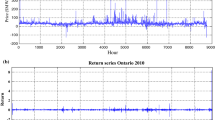Abstract
Forecasting electricity prices has been a widely investigated research issue in the deregulated power market scenario. High price volatilities, price spikes caused by a number of factors such as weather uncertainty, fluctuating fuel prices, transmission bottlenecks, etc., make the task of accurate price forecasting a formidable challenge for the market participants. A number of models have been proposed by researchers; however, achieving high accuracy is always not possible. In some specific applications such as self-scheduling by demand side participants, certain price thresholds are more useful than accurate price forecasts. In this paper, we have investigated the application of a novel neural network-based technique called extreme learning machine for the problem of classification of future electricity prices with respect to certain price thresholds. Different models corresponding to different lead times are developed and tested with data corresponding to Ontario and PJM markets. It is observed that classification with ELM is fast, less sensitive to user defined parameters and easily implementable.




Similar content being viewed by others
References
Zareipour H, Canizares C, Bhattacharya K, Thomson J (2006) Application of public-domain market information to forecast Ontario’s wholesale electricity prices. IEEE Trans Power Syst 21(4):1707–1717
Nogales F, Contreras J, Conejo A, Espinola R (2002) Forecasting next-day electricity prices by time series models. IEEE Trans Power Syst 17(2):342–348
Zhou M, Yan Z, Ni YX, Li G, Nie Y (2006) Electricity price forecasting with confidence-interval estimation through an extended arima approach. IEE Proc Gener Trans Distrib 153(2):187–195
Garcia R, Contreras J, van Akkeren M, Garcia J (2005) A garch forecasting model to predict day-ahead electricity prices. IEEE Trans Power Syst 20(2):867–874
Hong Y-Y, Hsiao C-Y (2002) Locational marginal price forecasting in deregulated electricity markets using artificial intelligence. IEE Proc Gener Transm Distrib 149(5):621–626
Rodriguez C, Anders G (2004) Energy price forecasting in the Ontario competitive power system market. IEEE Trans Power Syst 19(1):366–374
Ipakchi A, Albuyeh F (2009) Grid of the future. IEEE Power Energy Mag 7(2):52–62
Zareipour H, Canizares C, Bhattacharya K (2007) The operation of Ontario’s competitive electricity market: overview, experiences, and lessons. IEEE Trans Power Syst 22(4):1782–1793
Reddy M, Mohanta D (2008) Adaptive-neuro-fuzzy inference system approach for transmission line fault classification and location incorporating effects of power swings. IET Gener Transm Distrib 2(2):235–244
Mishra S, Bhende CN, Panigrahi BK (2008) Detection and classification of power quality disturbances using s-transform and probabilistic neural network. IEEE Trans Power Deliv 23(1):280–287
Gerbec D, Gasperic S, Smon I, Gubina F (2003) ‘Consumers’ load profile determination based on different classification methods. In: IEEE power engineering society general meeting, 2003, vol 2. p 995
Chow J-C, Fischl R, Kam M, Yan HH, Ricciardi S (1990) An improved hopfield model for power system contingency classification. In: IEEE international symposium on circuits and systems, 1990, vol 4. pp 2925–2928
Zareipour H, Janjani A, Leung H, Motamedi A, Schellenberg A (2011) Classification of future electricity market prices. IEEE Trans Power Syst 26(1):165–173
Huang G-B, Zhu Q-Y, Siew C-K (2006) Extreme learning machine: theory and applications. Neurocomputing 70:489–501
Zhu Q-Y, Qin AK, Suganthan AK, Huang G-B (2005) Evolutionary extreme learning machine. Pattern Recognit 38:1759–1763
Huang G-B, Babri HA (1998) Upper bounds on the number of hidden neurons in feedforward networks with arbitrary bounded nonlinear activation functions. IEEE Trans Neural Netw 9(1):224–229
Huang G-B (2003) Learning capability and storage capacity of two-hidden-layer feedforward networks. IEEE Trans Neural Netw 14(2):274–281
Huang G-B, Chen L, Siew C-K (2006) Universal approximation using incremental constructive feedforward networks with random hidden nodes. IEEE Trans Neural Netw 17(4):879–892
Rong H-J, Huang G-B, Ong Y-S (2008) Extreme learning machine for multi-categories classification applications. In: IEEE international joint conference on neural networks, 2008. IJCNN 2008. (IEEE world congress on computational intelligence). pp 1709–1713
Rong H-J, Ong Y-S, Tan A-H, Zhu Z (2008) A fast pruned-extreme learning machine for classification problem. Neurocomputing 72(1–3):359–366
Wang G, Zhao Y, Wang D (2008) A protein secondary structure prediction framework based on the extreme learning machine. Neurocomputing 72(1–3):262–268
Zhao X, Wang G, Bi X, Gong P, Zhao Y (2011) XML document classification based on ELM. Neurocomputing 74(16):2444–2451
Chen X, Dong ZY, Meng K, Xu Y, Wong KP, Ngan HW (2012) Electricity price forecasting with extreme learning machine and bootstrapping. IEEE Trans Power Syst 27(4):2055–2062
Website of Ontario electricity market (2012) http://www.ieso.ca @ONLINE, Dec 2012
Website of PJM Market (2012) http://www.pjm.com @ONLINE, Dec 2012
Serre D (2002) Matrices: theory and applications. Springer, New York
Rao C, Mitra S (1971) Generalized inverse of matrices and its applications. Wiley, New York
Deng W, Zheng Q, Chen L (2009) Regularized extreme learning machine. In: IEEE symposium on computational intelligence and data mining, 2009. CIDM’09. pp 389–395
Li C, Wang S (2006) Next-day power market clearing price forecasting using artificial fish-swarm based neural network. In: Wang J, Yi Z, Zurada J, Lu B-L, Yin H (eds) Advances in neural networks—ISNN 2006. Lecture notes in computer science, vol 3972. Springer, Berlin, pp 1290–1295
Mandal P, Senjyu T, Funabashi T (2006) Neural networks approach to forecast several hour ahead electricity prices and loads in deregulated market. Energy Convers Manag 47(15–16):2128–2142
Zhang L, Luh P (2005) Neural network-based market clearing price prediction and confidence interval estimation with an improved extended kalman filter method. IEEE Trans Power Syst 20(1):59–66
Author information
Authors and Affiliations
Corresponding author
Rights and permissions
About this article
Cite this article
Shrivastava, N.A., Panigrahi, B.K. & Lim, MH. Electricity price classification using extreme learning machines. Neural Comput & Applic 27, 9–18 (2016). https://doi.org/10.1007/s00521-013-1537-1
Received:
Accepted:
Published:
Issue Date:
DOI: https://doi.org/10.1007/s00521-013-1537-1




